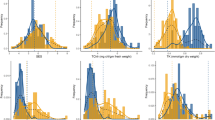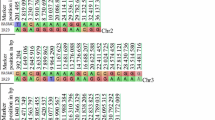Abstract
Salinity is a major constraint affecting rice productivity in rainfed and irrigated agro-ecosystems. Understanding salinity effects on rice production at the reproductive stage could improve adaptation for this trait. Identifying quantitative trait loci (QTLs) controlling adaptation to salinity may also accelerate breeding rice germplasm for environments prone to this stress. We used the salt tolerant landrace ‘Hasawi’ as a donor parent to generate three F2 offspring (consisting each of 500 individuals) with three African cultivars (‘NERICA-L-19’, ‘Sahel 108’ and ‘BG90-2’) used as recipient parents (RP). The F2s and F2:3s were evaluated for grain yield and other traits in saline fields. Salinity caused reduction in all measured traits across the F2-derived offspring, e.g. grain yield reduced between 65 and 73 %, but some offspring had twice the RP’s grain yield. QTL analysis revealed 75 QTLs for different traits in all 3 genetic backgrounds (GBs): 24 of them were common among all the 3 GBs while 31 were noted in 2 GBs, and 17 in one GB. ‘Hasawi’ contributed on average 49 % alleles to these QTLs. Two yield and yield related QTLs (qGY11 and qTN11) common in all 3 GBs were mapped on the same chromosomal segment suggesting these QTLs might be stable across different GBs. Four other QTLs were strongly associated with salinity tolerance with peak marker RM419, representing a potential candidate for MAS due to high LOD score and relatively large effect QTLs.




Similar content being viewed by others
Abbreviations
- CIM:
-
Composite interval mapping
- MAS:
-
Marker-aided selection
- PCR:
-
Polymerase chain reaction
- QTL:
-
Quantitative trait loci
- SES:
-
Standard evaluation system
- SMR:
-
Single-marker regression
- SSR:
-
Simple sequence repeats
References
Al-Mssallem MQ, Hampton SM, Frost GS, Brown JE (2011) A study of Hasawi rice (Oryza sativa L.) in terms of its carbohydrate hydrolysis (in vitro) and glycaemic and insulinaemic indices (in vivo). Eur J Clin Nutr 65:627–634
Ammar MHM, Pandit A, Singh RK et al (2009) Mapping of QTLs controlling Na+.K+ and CI- ion concentrations in salt tolerant indica rice variety CSR27. J Plant Biochem Biotechnol 18:139–150
Bimpong IK, Serraj R, Chin JH, Ramos J, Mendoza ETM, Hernandez J, Mendioro MS, Brar DS (2011) Identification of QTLs for drought-related traits in alien introgression lines derived from crosses of Rice (Oryza sativa cv IR64) × O. glaberrima under lowland drought stress. J Plant Bio 54:237–250
Chin JH, Kim JH, Kwon SW, Cho YI, Pia ZZ, Han LZ, Koh HJ (2003) Identification of subspecies specific RAPD markers in rice. Korean J Breed 35:102–108
Claes B, Dekeyser R, Villarroel R, Vandenbulcke M, Bauw G, Van Montagu M, Caplan A (1990) Characterization of a rice gene showing organ-specific expression in response to salt stress and drought. Plant Cell 2:19–27
Dellaporta SL, Wood J, Hicks JB (1983) A plant DNA minipreparation: version II. Plant Mol Bio Report 4:19–21
Evenson RE, Gollin D (1997) Genetic resources, international organization and improvement in rice varieties. Econ Dev Cult Change 45:471–500
Flowers TJ, Koyama ML, Flowers SA, Sudhakar C, Singh KP, Yeo AR (2000) QTL: their place in engineering tolerance of rice to salinity. J Exp Bot 51:99–106
Hossain M, Gollin D, Cabanilla V, Cabrera E, Jonson N, Khush GS, McLaren G (2003) International research and genetic improvement and its effect on productivity: the impact of international agricultural research. In: Evenson RE, Gollin D (eds) Crop variety improvement and its effect on productivity: the impact of international agricultural research. CABI, Wallingford, pp 71–107
Islam MR, Salam MA, Hassan L, Collard BCY, Singh RK, Gregorio GB (2011) QTL mapping for salinity tolerance at seedling stage in rice. Emir J Food and Agric 23:137–146
Ismail A, Tuong T (2009) Brackish water coastal zones of the monsoon tropics: challenges and opportunities. In: Haefele S, Ismail A (eds) Natural resource management for poverty reduction and environmental sustainability in rice-based systems. International Rice Research Institute, Los Banos, Philippines, pp 113–121
Jones MP (1986) Genetic analysis of salt tolerance in mangrove swamp rice, in Rice genetics. In: Proceedings of the international rice genetics symposium, 27–31 May 1985, Manila, Philippines. International Rice Research Institute, Metro Manila, Philippines, pp 411–422
Khatun S, Rizzo CA, Flower TJ (1995) Genotypic variation in the effect of salinity on fertility in rice. Plant Soil 173:239–250
Lançon F, Erenstein O (2002) Potential and prospects for rice production in West Africa. In: Sub-regional workshop on harmonization of policies and coordination of programmes on rice in the ECOWAS sub-region, Accra, Ghana, 25–28 February 2002. Bouake, Côte d’Ivoire: West Africa Rice Development Association. http://www.hubrural.org/IMG/pdf/potential-and-prospects-for-rice-production-wa.pdf
Lang NT, Yanagihara SS, Buu BC (2001) QTL analysis of salt tolerance in rice (Oryza sativa L.) SABRAO. J. Breed Genet 33:11–20
Lin HX, Zhu MZ, Yano M, Gao JP, Liang ZW, Su WA, Hu XH, Ren ZH, Chao DY (2004) QTLs for Na+ and K+ uptake of the shoots and roots controlling rice salt tolerance. Theor Appl Genet 108:253–260
Lutts S, Kinet JM, Bouhamont J (1995) Changes in plant response to NaCI during development of rice (Oryza sativa L.) Varieties differing in salinity resistance. J Exp Bot 46:1843–1852
Maas EV, Hoffiman GJ (1997) Crop salt tolerance-current assessment. J Irrig Drain Div ASCE 103(IR2):115–134
Mahmood IA, Quereshi RH, Aslam M (1999) Yield and quality of different rice (Oryza sativa L.) varieties as affected by soil salinity. Pak J Bot 31:475–479
McCouch SR, Cho YG, Yano M et al (1997) Report on QTL nomenclature. Rice Genet Newsl 14:11
McCouch S, Teytelman L, Xu Y et al (2002) Development of 2,240 new SSR markers for rice (Oryza sativa L.). DNA Res 9:199–207
Moradi F, Ismail AM (2007) Responses of photosynthesis, chlorophyll fluorescence and ROS scavenging system to salt stress during seeding and reproductive stage in rice. Ann Bot 99:1161–1173
Nakhoda B, Leung H, Mendioro MS, Mohammadi-nejad G, Ismail AM (2012) Isolation, characterization, and field evaluation of rice (Oryza sativa L., var. IR64) mutants with altered responses to salt stress. Field Crops Res 127:191–202
Negrao S, Courtois B, Ahmadi N, Abreu I, Saibo N, Oliveira MM (2011) Recent updates on salinity stress in rice: from physiological to molecular responses. Crit Rev Plant Sci 30:329–377
Nelson JC (1997) QGENE: software for marker-based genomic analysis and breeding. Mol Breed 3:239–245
Neraja CN, Maghirang-Rodriguez R, Pamplona A, Heuer S, Collard BCY, Septiningsih EM, Vergara G, Sanchez D, Xu K, Ismail AM et al (2007) A marker-assisted backcross approach for developing submergence-tolerant rice cultivars. Theor Appl Genet 115:767–776
Reddy MP, Sarla N, Laxminarayana SN, Reddy V, Siddiq EA (2005) Identification and mapping of yield and yield related QTLs from an Indian accession of Oryza rufipogon. BMC Genet 6:33
Ren ZH, Gao JP, Li LG, Cai XL, Huang W, Chao DY, Zhu MZ, Wang ZY, Luan S, Lin HX (2005) A rice quantitative trait locus for salt tolerance encodes a sodium transporter. Nat Genet 37:1141–1146
Sabouri H, Sabouri A (2009) New evidence of QTLs attributed to salinity tolerance in rice. Afr J Biotechnol 7:4376–4383
Sabouri H, Reizai AM, Mouomeni A, Kavoussi M, Sabouri A (2009) QTLs mapping of physiological traits related to salt tolerance in young rice seedlings. Biol Plant 53:657–662
SAS Institute Inc (2004) SAS/STAT® 9.2 user’s guide. SAS Institute Inc, Cary, North Carolina
Septiningsih EM, Pamplona AM, Sanchez DL, Neeraja CN, Vergara GV, Heuer S, Ismail AM, Mackill DJ (2009) Development of submergence tolerant rice cultivars: the Sub1 locus and beyond. Ann Bot 103:151–160
Singh SP (1999) Developments in plant breeding: common bean improvement in the twenty-first century. Kluwer Academic Publishers, Dordrecht
Singh RK, Flower TJ (2010) The physiology and molecular biology of the effects of salinity on rice. In: Pessarakli M (ed) Handbook of plant and crop stress, 3rd edn. Taylor and Francis, Boca Raton, Florida
Takehisa H, Shimodate T, Fukuta Y, Ueda T, Yano M, Yamaya T, Kameya T, Sato T (2004) Identification of quantitative trait loci for plant growth of rice in paddy field flooded with salt water. Field Crops Res 89:85–95
Temnykh S, DeClerck G, Lukashova A, Lipovich L, Cartinhour S, McCouch S (2001) Computational and experimental analysis of microsatellites in rice (Oryza sativa L.): frequency, length variation, transposon associations and genetic marker potential. Genome Res 11:1441–1452
Thomson M, de Ocampo M, Egdane J et al (2010) Characterizing the Saltol quantitative trait locus for salinity tolerance in rice. Rice 3:148–160
Xu YB, Crouch JH (2008) Maker-assisted selection in plant breeding from publications to practice. Crop Sci 48:391–407
Zang J, Sun Y, Wang Y et al (2008) Dissection of genetic overlap of salt tolerance QTLs at the seedling and tillering stages using backcross introgression lines in rice. Sci China Ser C Life Sci 51:583–591
Zeng L, Shannon MC, Grieve CM (2002) Evaluation of salt tolerance in rice genotypes by multiple agronomic parameters. Euphytica 127:235–245
Author information
Authors and Affiliations
Corresponding author
Rights and permissions
About this article
Cite this article
Bimpong, I.K., Manneh, B., Diop, B. et al. New quantitative trait loci for enhancing adaptation to salinity in rice from Hasawi, a Saudi landrace into three African cultivars at the reproductive stage. Euphytica 200, 45–60 (2014). https://doi.org/10.1007/s10681-014-1134-0
Received:
Accepted:
Published:
Issue Date:
DOI: https://doi.org/10.1007/s10681-014-1134-0




